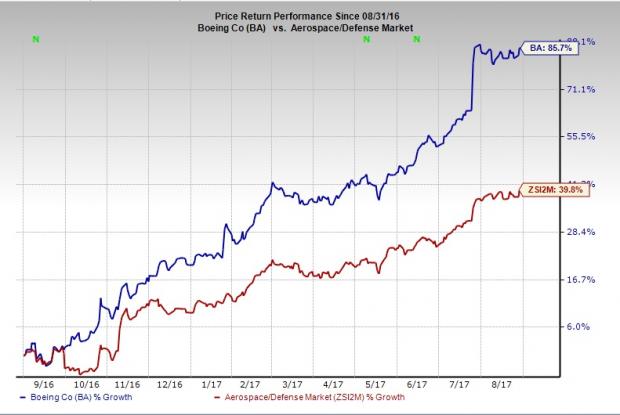Aerospace behemoth The Boeing Co. (NYSE:BA) won a modification contract for upgrading F-15 Radar Modernization program (RMP).Work related to the deal is scheduled to be over by Apr 30, 2020.
Valued at $94.9 million, the contract was awarded by the Air Force Life Cycle Management Center, Wright-Patterson Air Force Base, OH. Per the terms of the agreement, the modification includes exercise of options for 13 RMP Group A kits, 13 RMP Group B kits, 38 RMP installs, 14 conformal fuel tank installs, and other required support being produced under the original contract. Work will be executed in St. Louis, MO.
A Brief Note on F-15 & RMP
Boeing’s F-15 Strike Eagle is a twin-engine, all weather tactical fighter aircraft. Its proven design is undefeated in air-to-air combat, with more than 100 aerial combat victories.
Under the F-15 RMP, the legacy APG-70 mechanically-scanned radar incorporated in F-15 jets is replaced with an active electronically-scanned array (AESA) system - the APG-82(V)1 radar. Notably, APG-82 V1, manufactured by defense prime Raytheon Company (NYSE:RTN) , optimizes the F-15’s multirole mission capability. It includes extended-range, superior multi-target tracking and precision engagement potential. This version also enhances the system’s reliability over the prior model of APG-70 radar.
Other hardware and software modifications comprising the RMP effort include a more powerful Environmental Control System, updates to the aircraft Operational Flight Program and Electronic Warfare software, a new radio frequency tunable filter and aircraft modifications.
What’s Favoring Boeing?
Boeing is one of the largest aerospace and defense contractors, with its defense business standing out among peers on virtue of its broadly diversified programs, strong order bookings and backlog. The company has been receiving several contracts from the Pentagon to install the APG-82 radar systems on its F-15E fighter-bombers. With the installation of these radar systems, high-resolution ground-mapping data has been enabled in the F-15, which helps the crew to identify targets from great distances and increases situational awareness, lethality and survivability.
Till date, Boeing has manufactured more than 1,600 of the aircraft for six countries and none of them plan to retire the F-15, thereby indicating this jet’s enhanced sustainability. In 2016, the company delivered 15 F-15s, up 25% from the year-ago tally. Considering the recent contract for RMP and the escalating geopolitical tension across the globe, we may expect increased demand for Boeing’s combat proven aircraft in days ahead. This in turn, will boost the company’s revenue growth trajectory.
Price Movement
Boeing’s stock has moved up 85.7% in the last one year, outperforming the broader industry’s gain of 39.8%.This might have been led by the company’s strong balance sheet and cash flows which provide financial flexibility in matters of incremental dividend, ongoing share repurchases and earnings accretive acquisitions. The company also poses strong competition to its peers like General Dynamics Corp. (NYSE:GD) and Huntington Ingalls Industries, Inc. (NYSE:HII) .

Zacks Rank
Boeing currently sports a Zacks Rank #2 (Buy). You can see the complete list of today’s Zacks #1 Rank (Strong Buy) stocks here.
4 Surprising Tech Stocks to Keep an Eye On
Tech stocks have been a major force behind the market’s record highs, but picking the best ones to buy can be tough. There’s a simple way to invest in the success of the entire sector. Zacks has just released a Special Report revealing one thing tech companies literally cannot function without. More importantly, it reveals 4 top stocks set to skyrocket on increasing demand for these devices. I encourage you to get the report now – before the next wave of innovations really take off.
Boeing Company (The) (BA): Free Stock Analysis Report
General Dynamics Corporation (GD): Free Stock Analysis Report
Huntington Ingalls Industries, Inc. (HII): Free Stock Analysis Report
Raytheon Company (RTN): Free Stock Analysis Report
Original post
Zacks Investment Research
